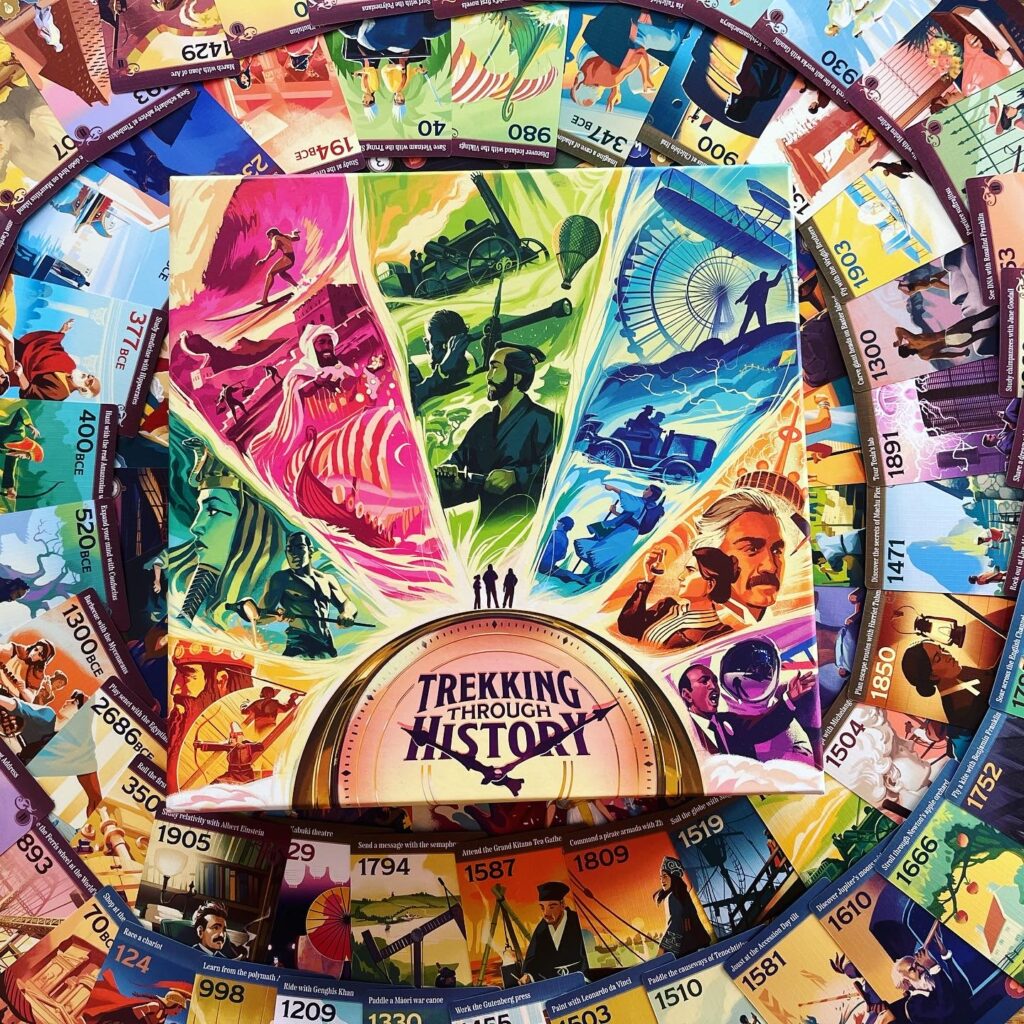The best way to succeed in the future is by understanding the present, and to understand the present, we need to learn about history. By studying prominent figures, historical events, cultures and stories, analytically approaching them and putting them in perspective in our own contemporary context, we can analyse certain events, problems and tensions in our own time. History repeats itself, and by explaining and commenting on the impact of history, we may be able to similarly predict our impact on the future. The world has experienced a lot of good, bad, neutral and also crazy things. I would love to learn more about our history and even better: experience it. However, time machines are very much a thing of fiction and, if Back to the Future and Hot Tub Time Machine are to be believed, also very paradoxical.

In Trekking Through History, you and your fellow players have the opportunity to travel through time like a real Doc Brown for three days to visit historical happenings. Without consequences. Attend Martin Luther King Jr.’s speech, take one of the first human flights together with the Wright brothers, study the work of Marie Curie or behold one of the first cave paintings. In Trekking Through Time, players literally follow in the footsteps of their ancestors and try to have the most (chronological) experiences. Who will write history and who becomes history?
In Trekking Through History, each turn a player visits a card (a historical event) and collect the corresponding coins (experiences). First, players lay down a playmat, set out GameTrayz’s tray filled to the brim with coins, shuffle the three decks of cards, each player gets 4 itineraries and places their pocket watches on the time track.
Gameplay
Similar to Patchwork, the turn order of the game depends on players’ position on the time track. The player who is at the back (and, in the case of a tie, on top) of the track takes their turn. Attending historical events takes time. Each card shows how much time a visit costs. When a player takes a card, he or she must move the amount of time indicated on the card on the time track. By turning in time crystals, a visit costs less time. Time is precious and think carefully about how to kill time. By planning well and visiting ‘cheaper’ events and deploying crystals cleverly, a player can easily play several turns in a row. The time track shows 12 hours and when all players have reached the end of the time track, a day (round) is over and the next day begins. After three days, the game is over.
Why ‘waste’ time visiting events? First, these visits provide experiences. There are symbols depicted on each card and on the play mat that indicate certain experiences. When a player chooses a card, that player also gets the related experience tokens. Each player chooses an itinerary each day. These itineraries have spots where players can place these tokens. By placing tokens and completing rows, players can earn points and also time crystals. Each card also contains a year corresponding to the event. With collected cards players will lay down a chronological timeline. Cards must be placed chronologically and otherwise players must put aside their current timeline in a stack and start a new one. Players receive points for each of their timeline stacks at the end of the game. The longer the timeline, the more points. Note, however, that very short timelines do not earn points or even minus points.
Verdict
Trekking Through History is an elegant, fast and simple game that is tremendously beautifully and colourfully designed with components of particularly high quality (the playing mat, GameTrayz inlay, plastic coins and beautiful large cards). The game is elegant in that each turn is similar, but players have plenty of choices. Each turn practically consists of a single interplay of actions: grab a card, advance on the time track and earn coins and possibly points, but players need to think carefully about which events they collect. Both playing out your route book and extending your timeline earn points, but only by making the right decisions can you maximise the points to be gained. Will you go for lots of experiences or an event from long, long ago? Because the actions are simple and the objective is clear, the game is a perfect introduction for novice players. Due to the various choices, short playing time, nice game material and elegant character, it is also well suited for experienced players who want to play a more light-hearted game. For me, a hobby historian, trivia tiger and avid Wikipedia scroller, the game has another major selling point: similar to Trekking the World, another game with light gameplay and a similar theme by the same publisher, all the cards contain facts and descriptions of different events. This also gives the game a lighthearted educational element, allowing players to learn more about the various events.
The game is available now and can be purchased here.








